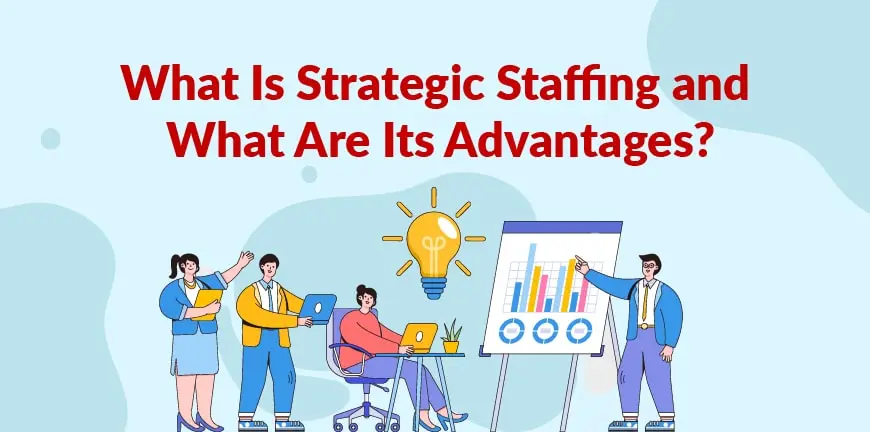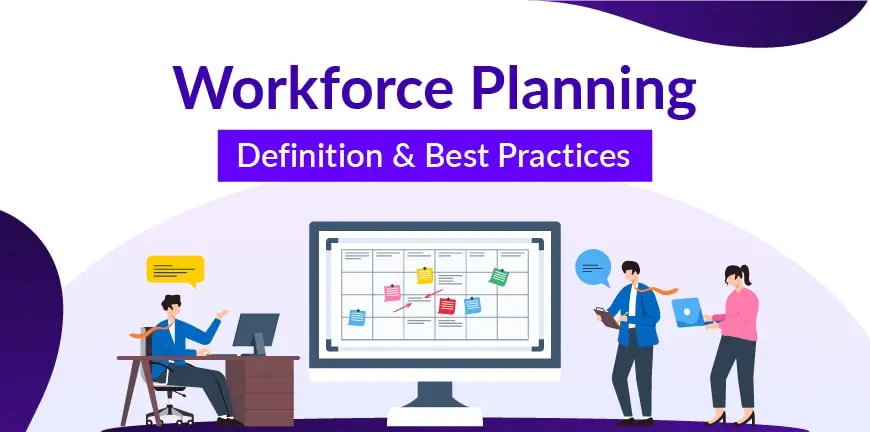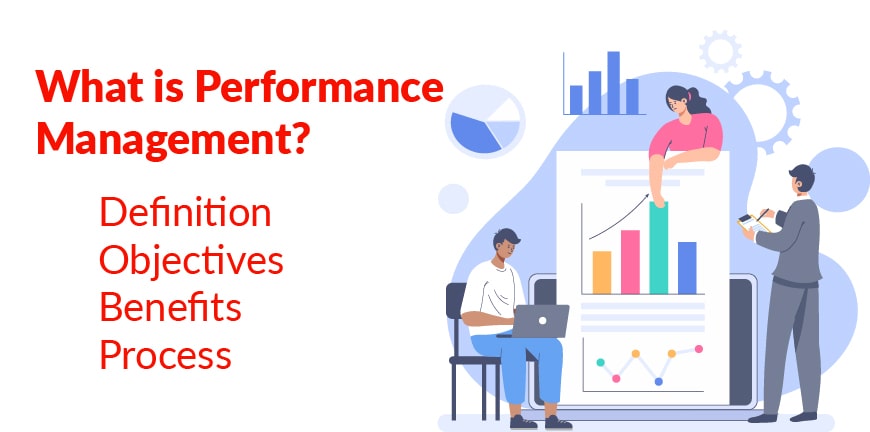
What Is Strategic Staffing and What Are Its Advantages?
09/10/2024
10 Ways Data Analytics Improves Recruitment
16/10/2024Workforce planning is a strategic activity that not only involves HR but also the senior management and others in a company. It is when the whole company comes together to acknowledge the current needs of the workforce, develops an outlook for how things will change in the future, and builds a plan.
What Is Workforce Planning?
Workforce planning is a strategic activity that ensures organizations have the right people in the right roles at the right time, so that it benefits the organization the most. In other words, it is a workforce optimization strategy that relies on metrics, business goals and meticulous planning and execution by HR.
What is the Importance of Strategic Workforce Planning?
1. Helps Alignment with Goals
Strategic workforce planning helps align your workforce with your business goals. This ensures that your employees and the departments and units within your company know what steps to take and at what time.
2. Recruitment Is More Efficient
Workforce planning also ensures that recruitment processes are more streamlined and more effective, thereby leading to better recruits. It also avoids the need for unnecessary recruitment when upskilling is a better option.
3. Hiring Costs Are Reduced
As more and more people within your company are encouraged to upskill, the number of new hands will be reduced or will be moved to more specialized roles. This will reduce the hiring costs significantly.
4. Boosts Employee Engagement
Strategic workforce planning also enables HR to understand the capabilities and comforts of everyone, helping them become better versions of themselves, even assigning them to different teams.
5. Improves Employee Retention
Such employee engagement in turn ensures that the employees do not leave the company without due notice and that they will be happy and motivated to continue working, giving the company’s reputation a boost too.
6. Increases Productivity
Workforce planning ensures that your business is always adequately staffed, helping to meet challenges when they come up and giving productivity a boost too.
7. Easier to Identify Skill Gaps
Workforce planning can also help identify skill gaps in your workforce, ensuring that the right training can be provided to the employees, making them suitable to fill more senior roles or even get transferred to another process.
What are the Steps to Effective Workforce Planning?
1. Decide on the Plan
You need to work a plan out before you begin optimizing your workforce’s capabilities through workforce planning and decide what you need to add to get things right. You need to decide where to start. The business needs to decide on the senior management who will be involved in the workforce planning. It needs to decide what aspects of the workforce they want to optimize, set targets, and what timeframe do they commit themselves to before they check if they have achieved their targets.
2. Analyze the Present Situation
Analyze the talent onboard the company. Understand the skills they have, both common and uncommon, and then plan what skills they would need training in and how you will conduct the training. Also understand the seniority levels of your employees, and if anyone is eligible to be promoted and how many can be mentors and so on.
3. Strategize What to Do Next
Now think about the immediate next steps. Do not think too far ahead as of now, if you are starting out in workforce planning. What are the skills you find scarce in your teams? What can be done to eliminate these skill gaps? How soon do you need to fix these skill gaps? Do you opt for training your present workforce or do you recruit new candidates with the necessary skills? These are some of the questions you need to ask.
4. Understand Priorities
The next step is to think about the priorities. Assign priorities to each of the tasks. So, do you hire the best leaders to take your business forward or do you hire a senior manager who has the necessary skills, or do you focus on skill enhancement? How would you prioritize each of these tasks and what justifications do you have? Who will oversee the workforce planning and how frequently would the tactics be reviewed?
5. Fixes and Initiatives
The next step is to think about fixes to all your prioritized tasks first and others later. What will you do to get the leader you want? What steps will you take exactly? If you want to conduct training for your present employees or recruit and train new employees, would you be opting for a training partner or will you do it in-house? What initiatives can you take to ensure that the fixes you have suggested work for your business? These are some of the questions that you must ask enroute to solving your problems in workforce planning.
6. Measure Results
Did your fixes work? What do the analytics say? You may need the help of a data analyst in this step. You may also need to prepare reports to justify the steps you took to your senior management. This will help secure buy-in from the leaders of the company for future actions taken in workforce planning.
Workforce Planning Best Practices
The duration of the workforce planning program is up to a year or two before review when it comes to a startup whereas it might be a little longer when it comes to a medium-sized business and still longer for an enterprise. However, the steps you need to take are about the same regardless of how long you continue your workforce planning before a review.
1. Planning Phase of Workforce Planning Should Be Given Due Time
Take time to ensure that the workforce planning you would be doing is guided by a solid strategy. Do not hurry in the initial stages of your workforce planning, or there will be a lack of clarity and errors will also get into the process.
2. Bring in More Stakeholders but Put Few in Charge of Overseeing the Process
You need the buy-in of all the people connected with strategic workforce planning in your company. This includes everyone from senior executives to mid-level managers to team leaders. You need to explain why you are undertaking workforce planning and how you are going to achieve your goals. But even as you do this, only a selected few in the top management must have the ability to directly alter an objective or plan.
3. HR Shouldn’t Be the Only People Involved
There’s a world beyond HR, that of procurement, operations and development and support that HR is not necessarily familiar with. All of these activities have a cascading effect on the workforce needs and requirements and the goals you have envisioned. This calls for involvement of senior management from different verticals and horizontals of the company. They will be better able to guide the workforce planning process.
4. Define Your KPIs
Focus on the KPIs that matter for the process of workforce planning. These KPIs are but not limited to quality of hire, average tenure of hires, net promoter score (NPS), and time to hire. Also, describe each KPI and why it is relevant for workforce planning and what is influencing that KPI. This will not only help define the KPI in a better way for people who aren’t aware of the technicalities, but they will also know the why and how to do it, so they can submit their own suggestions.
5. Use Labor Market Insights
Make use of labor market insights to ensure that you understand the current requirements and hiring trends in the market, where you are likely to fall short or overcompensate, and what you can do to find the right balance. These labor market insights can be obtained from public sources of authority or from special third-party data providers with an interest in HR or the labor market in general.
These are of course just some of the things you can do to ensure your workforce planning is on track. It doesn’t stop there and other adjustments to operations, hiring techniques, and even salary adjustments may be necessary.
Frequently Asked Questions
How is workforce planning different from workforce management?
Workforce planning is the process of planning how your workforce will be in the future and is generally a long-term strategic process, whereas workforce management is a short-term, tactical approach to ensuring your workforce is working as expected.
What are the key steps to effective workforce planning?
Effective workforce planning involves several steps, the key ones being initial planning, situational analysis, prioritization, suggesting fixes and initiatives, and so on.
Why is workforce planning important?
Workforce planning is very important because it helps meet current client needs, retain employees for longer, enables better training initiatives, boosts employee engagement, and eventually, builds a better reputation for the company.
Contact Us For Business Enquiry

Rajkumar Shanmugam
Rajkumar Shanmugam is the Head of HR at ALP Consulting, bringing over 19 years of comprehensive HR leadership experience across India and international markets. His expertise spans talent acquisition, employee relations, performance management, compliance, and HR transformation. Rajkumar has a proven track record of driving people-centric initiatives, enhancing workplace culture, and aligning HR strategy with business goals. With extensive experience in US staffing operations and global mobility, he continues to lead organizational excellence through innovation and employee engagement.




